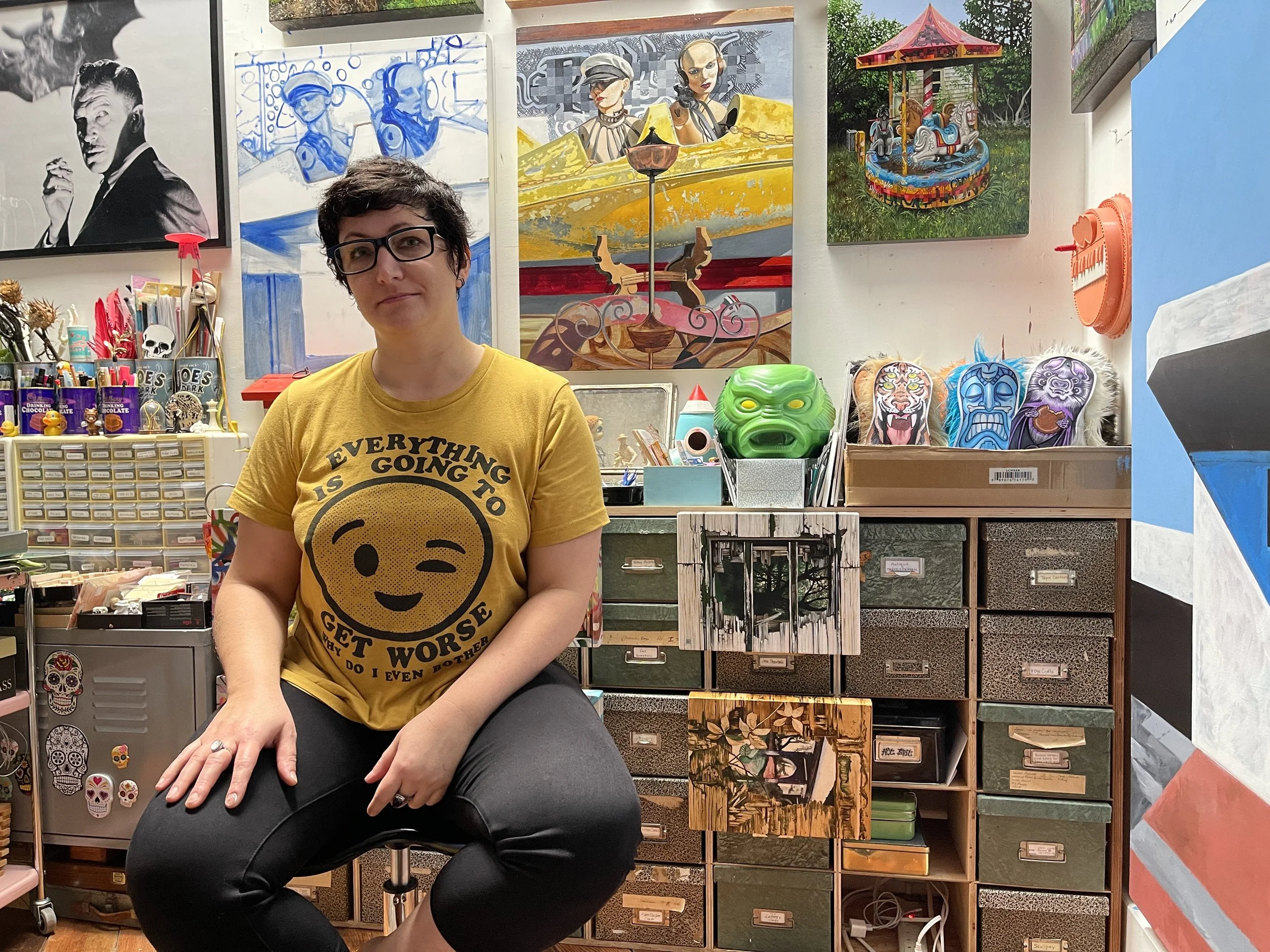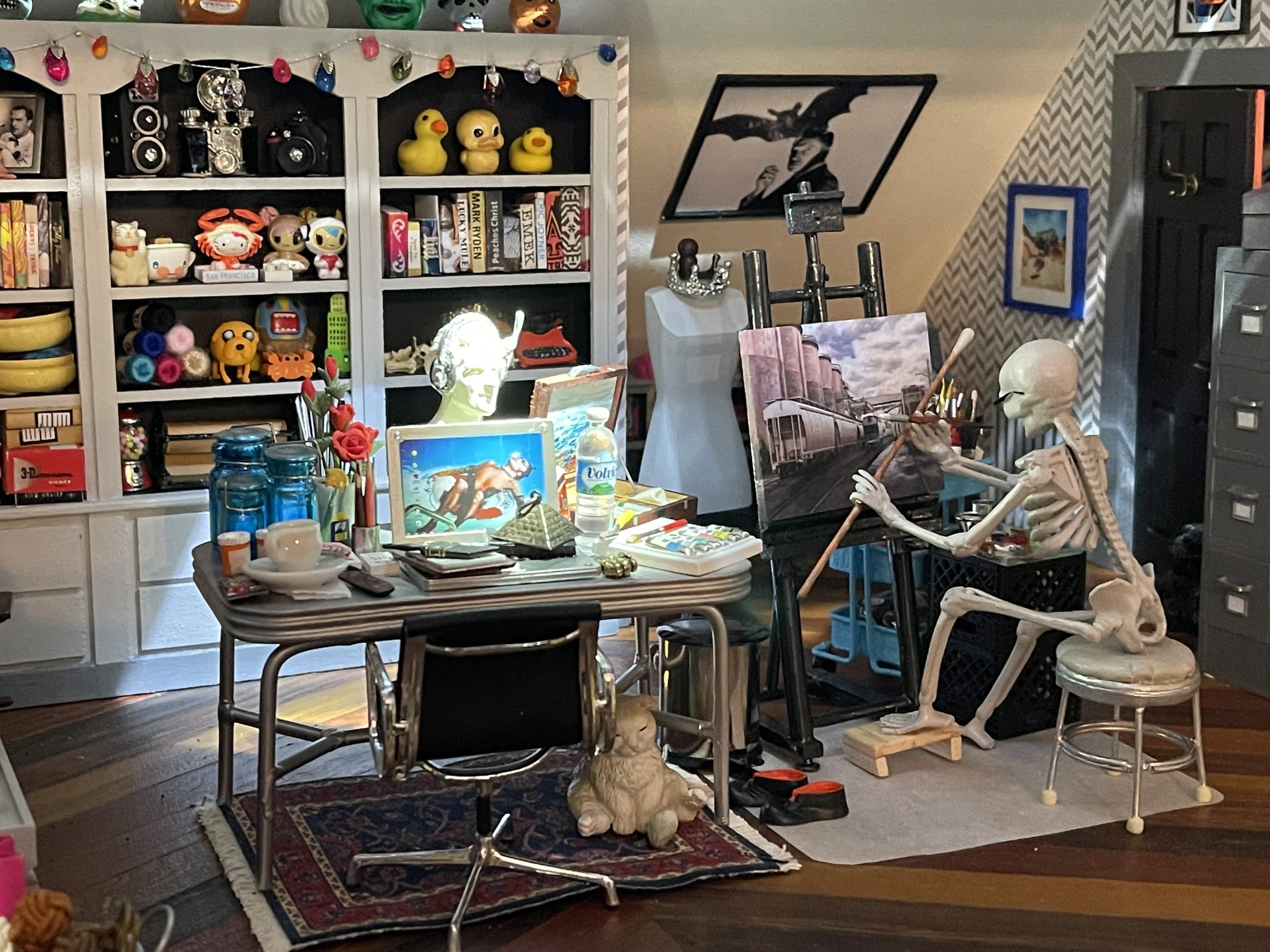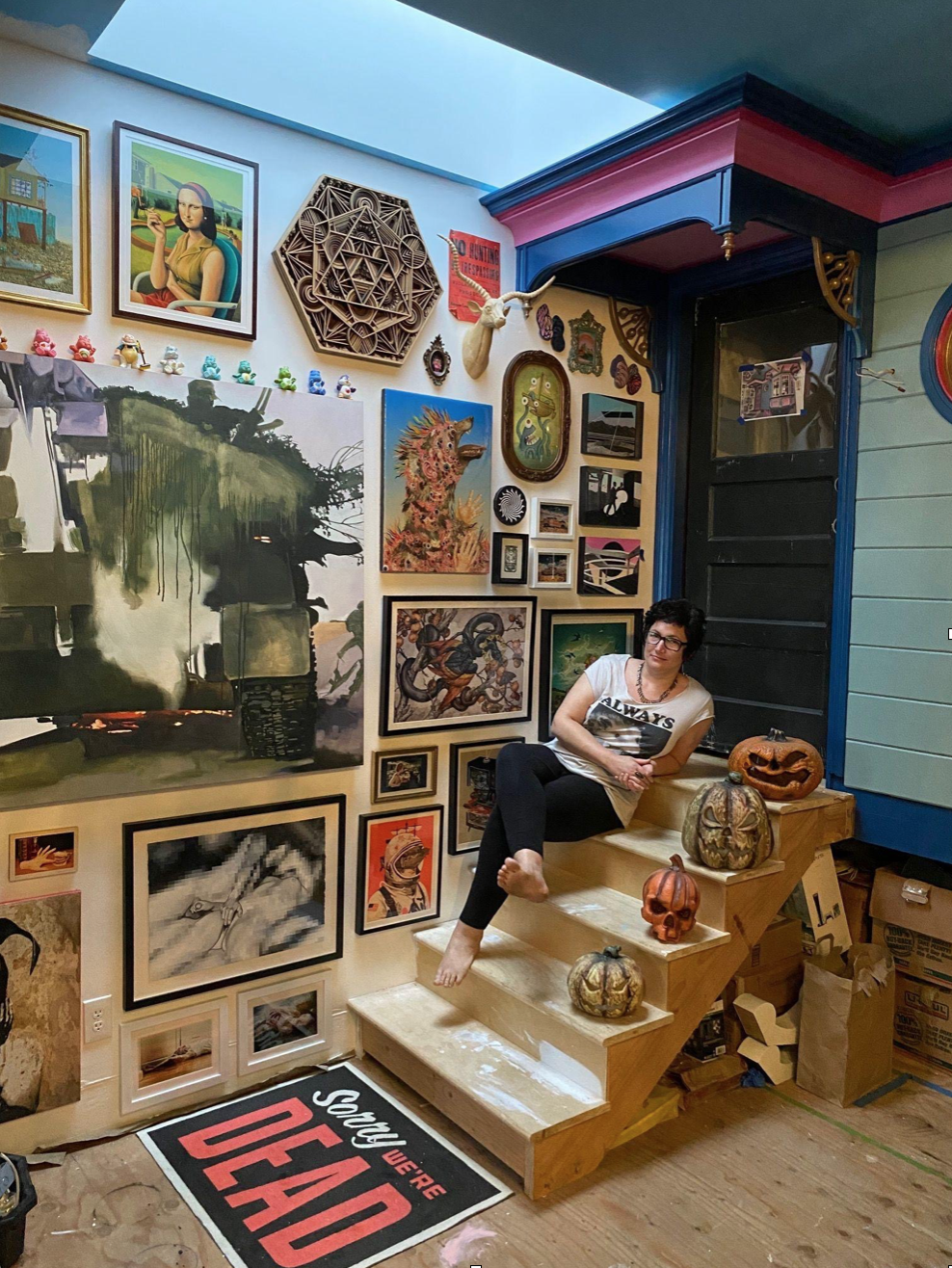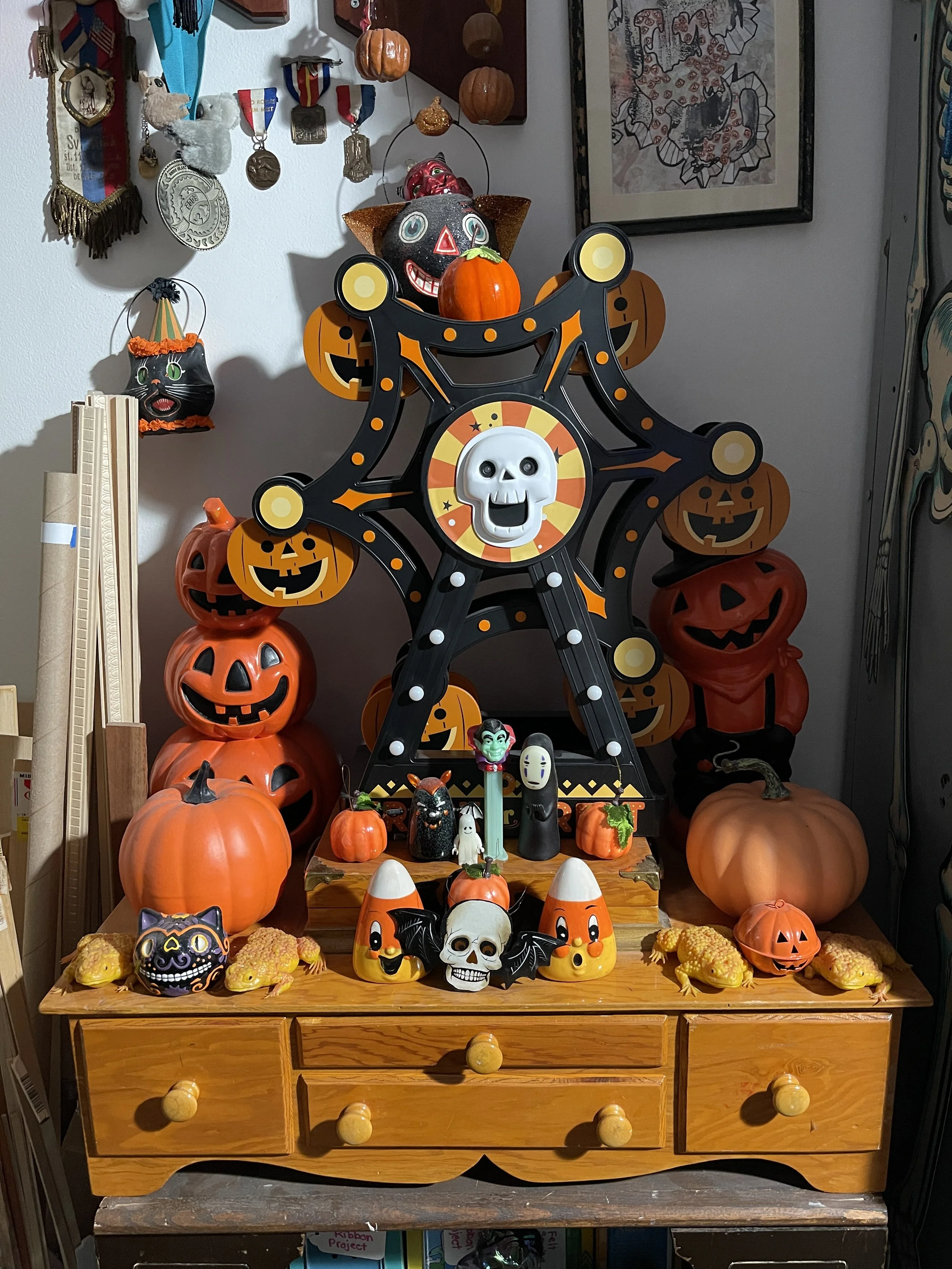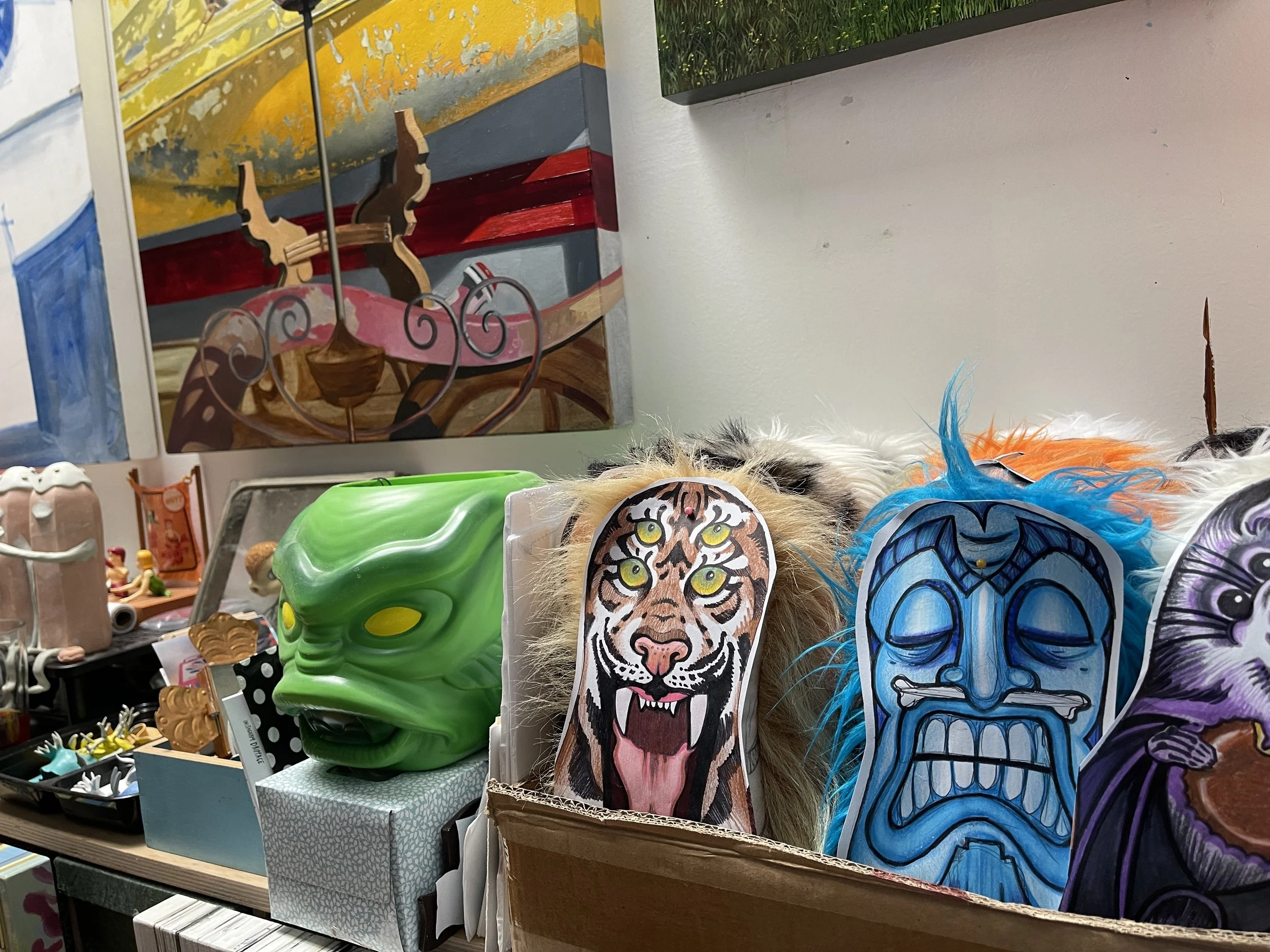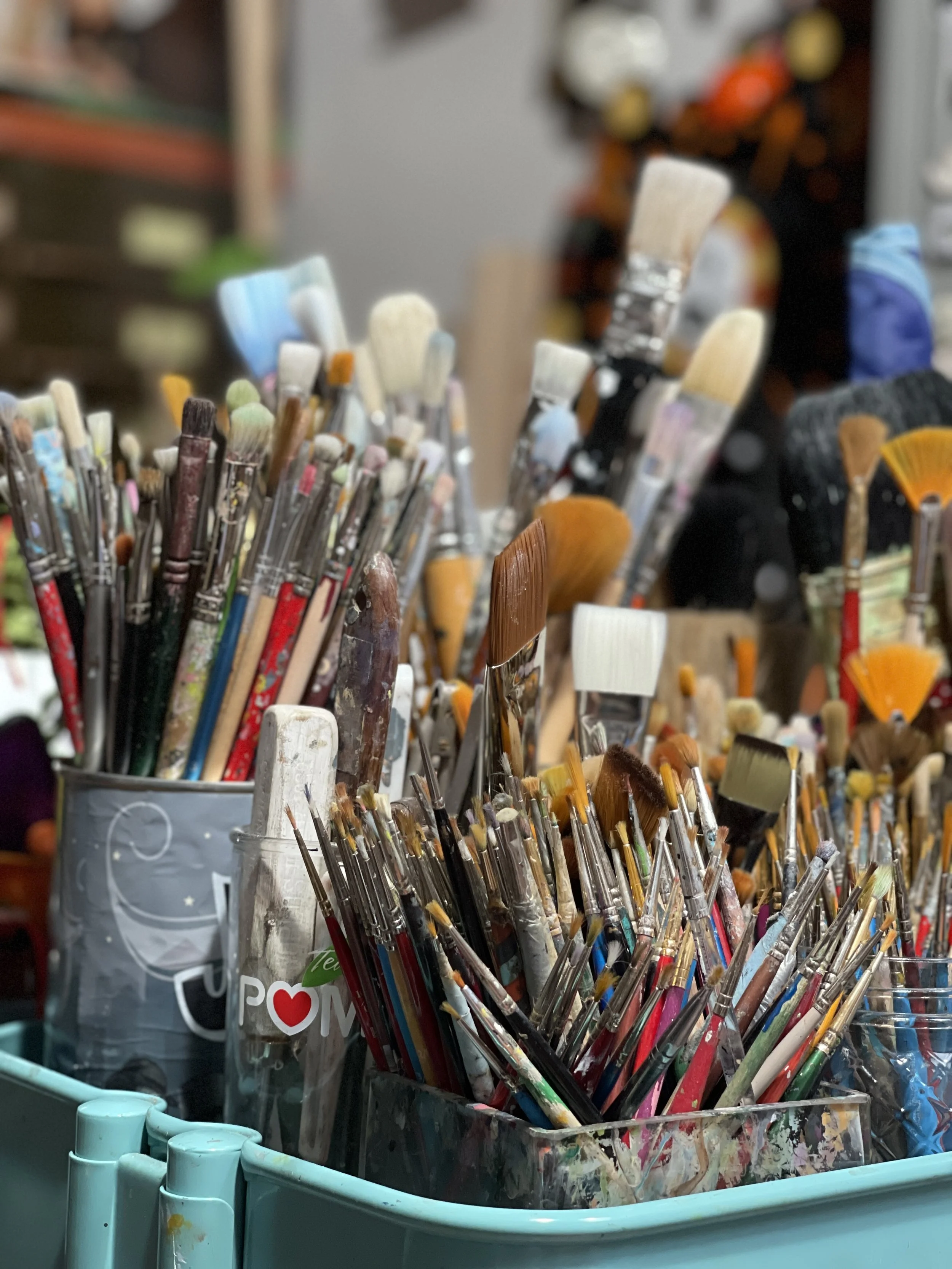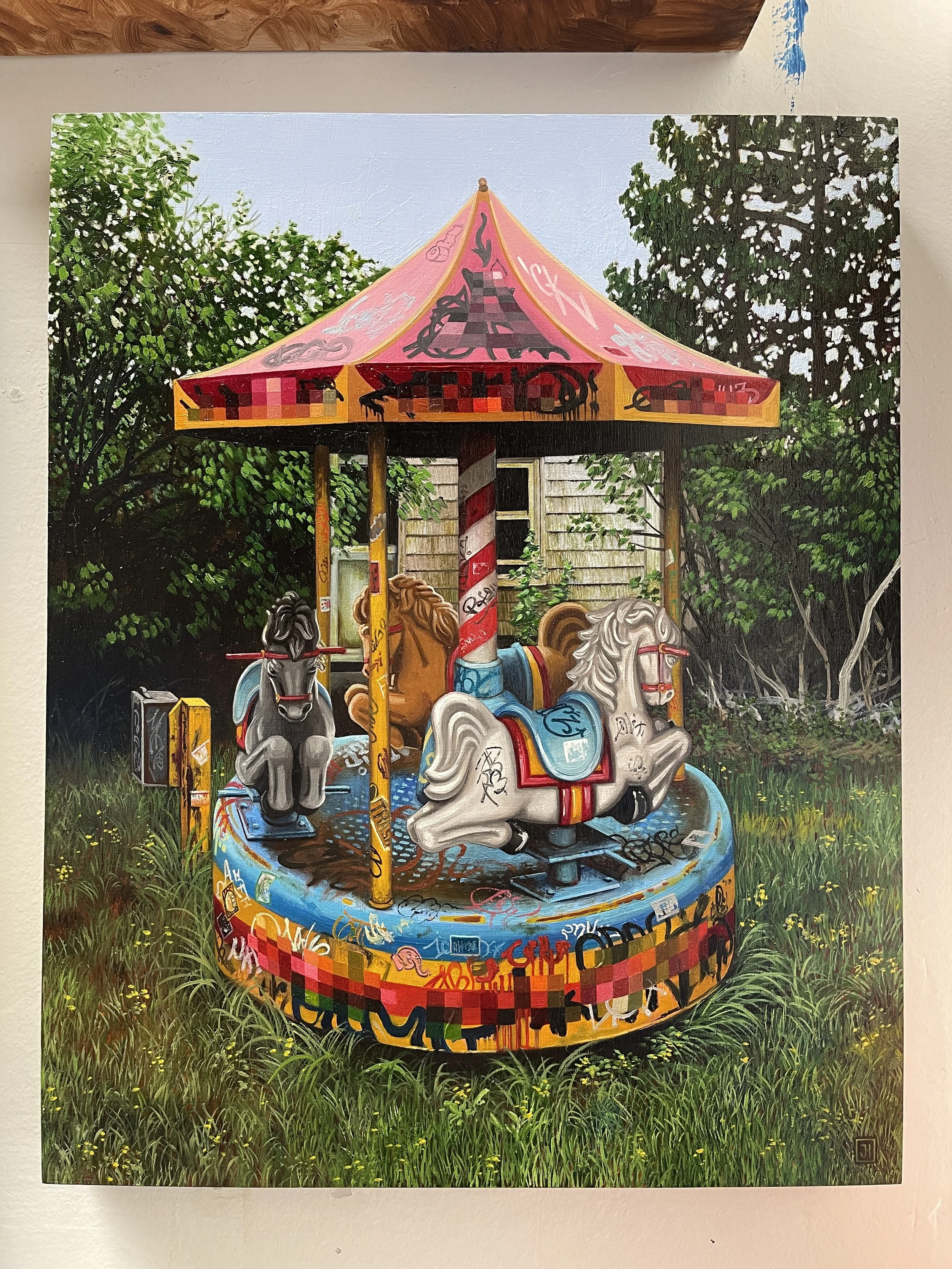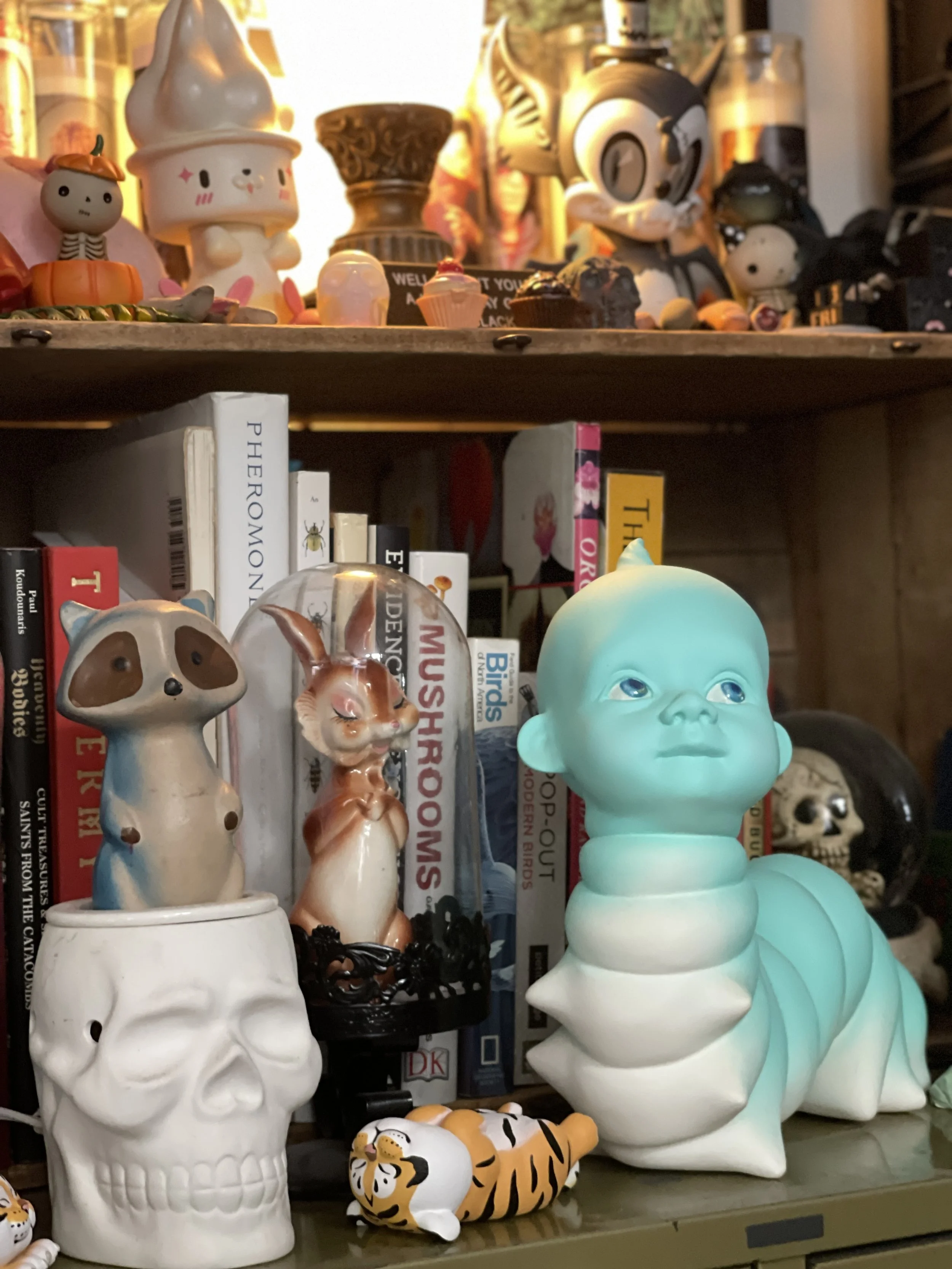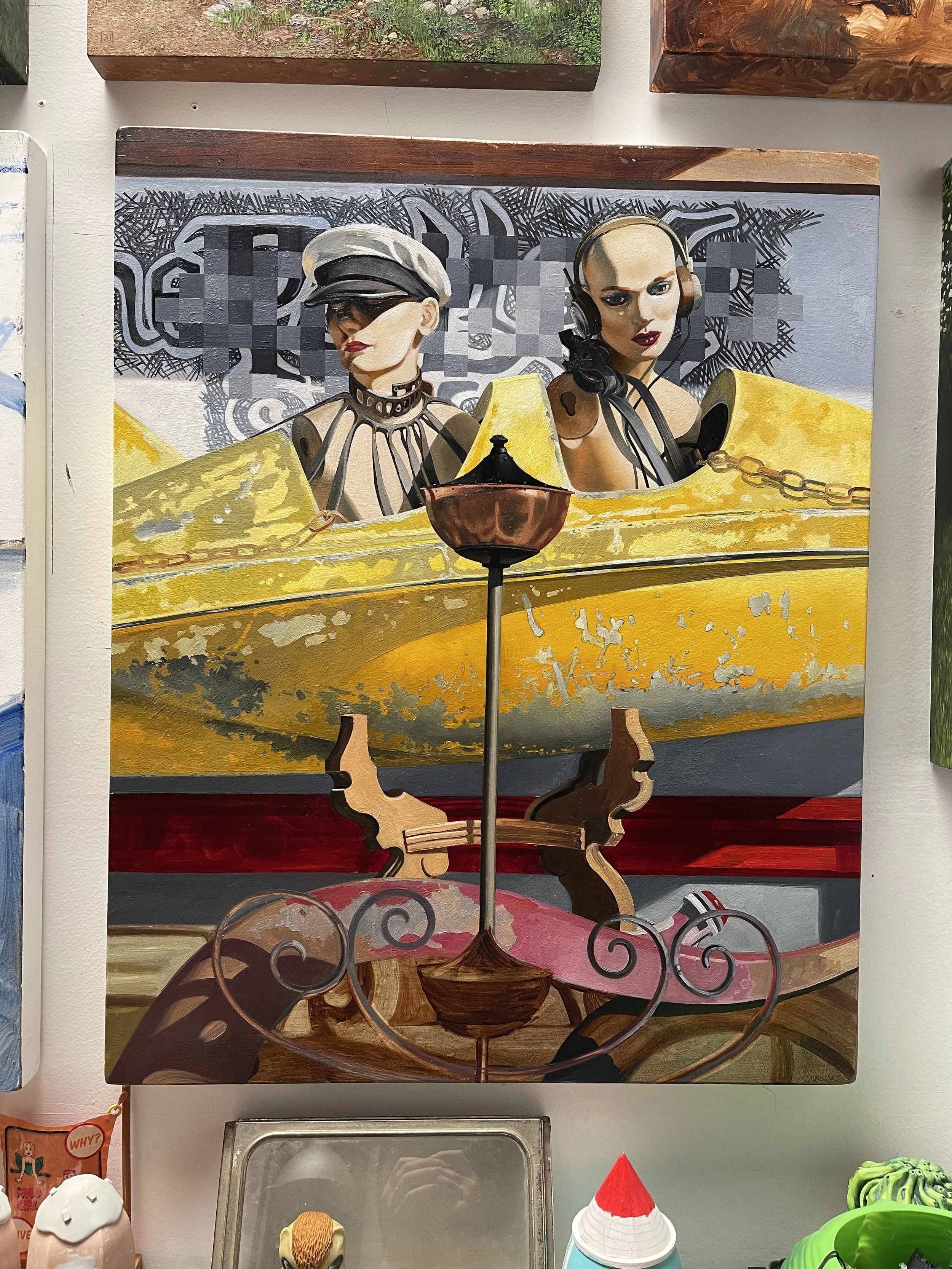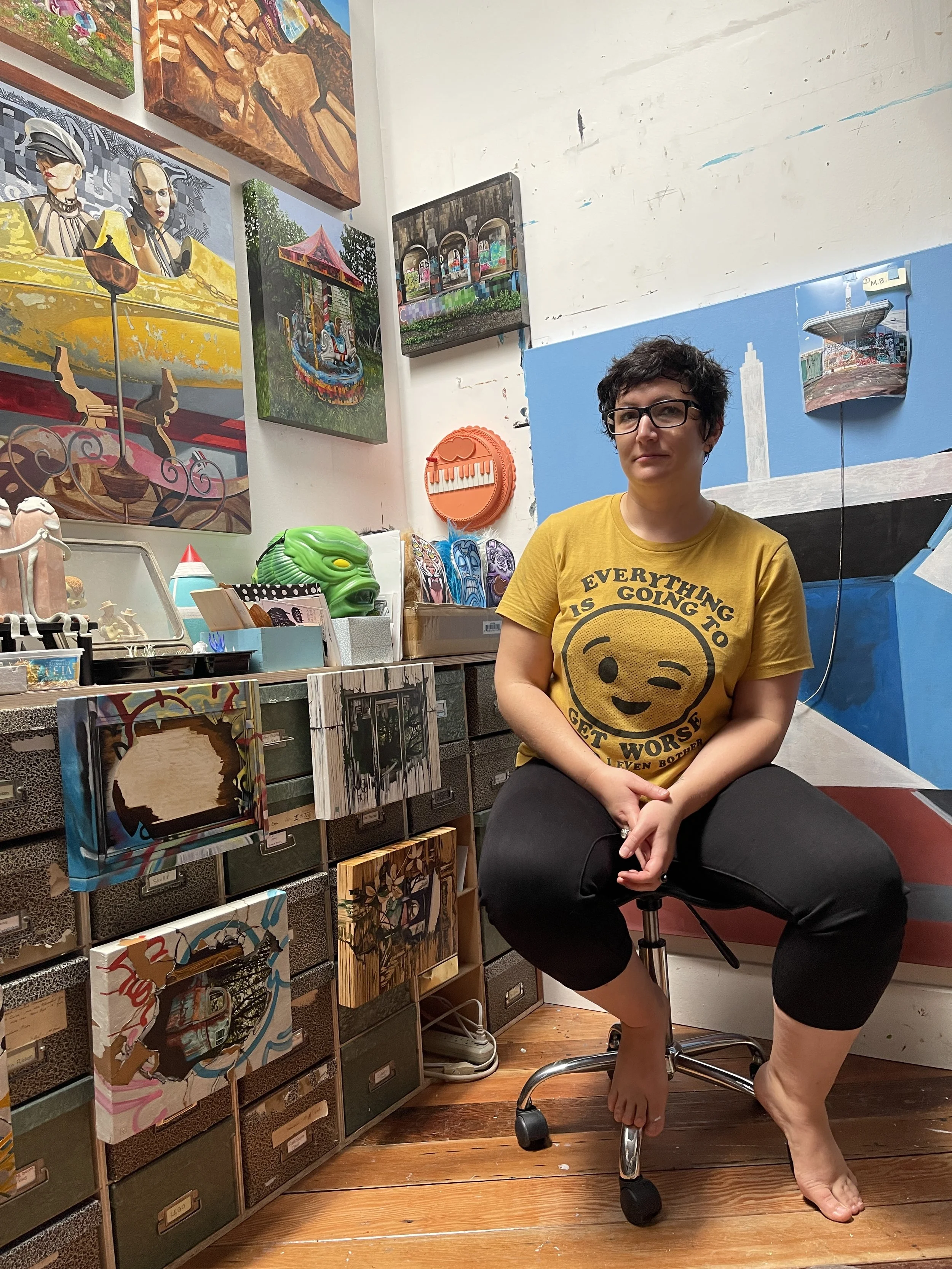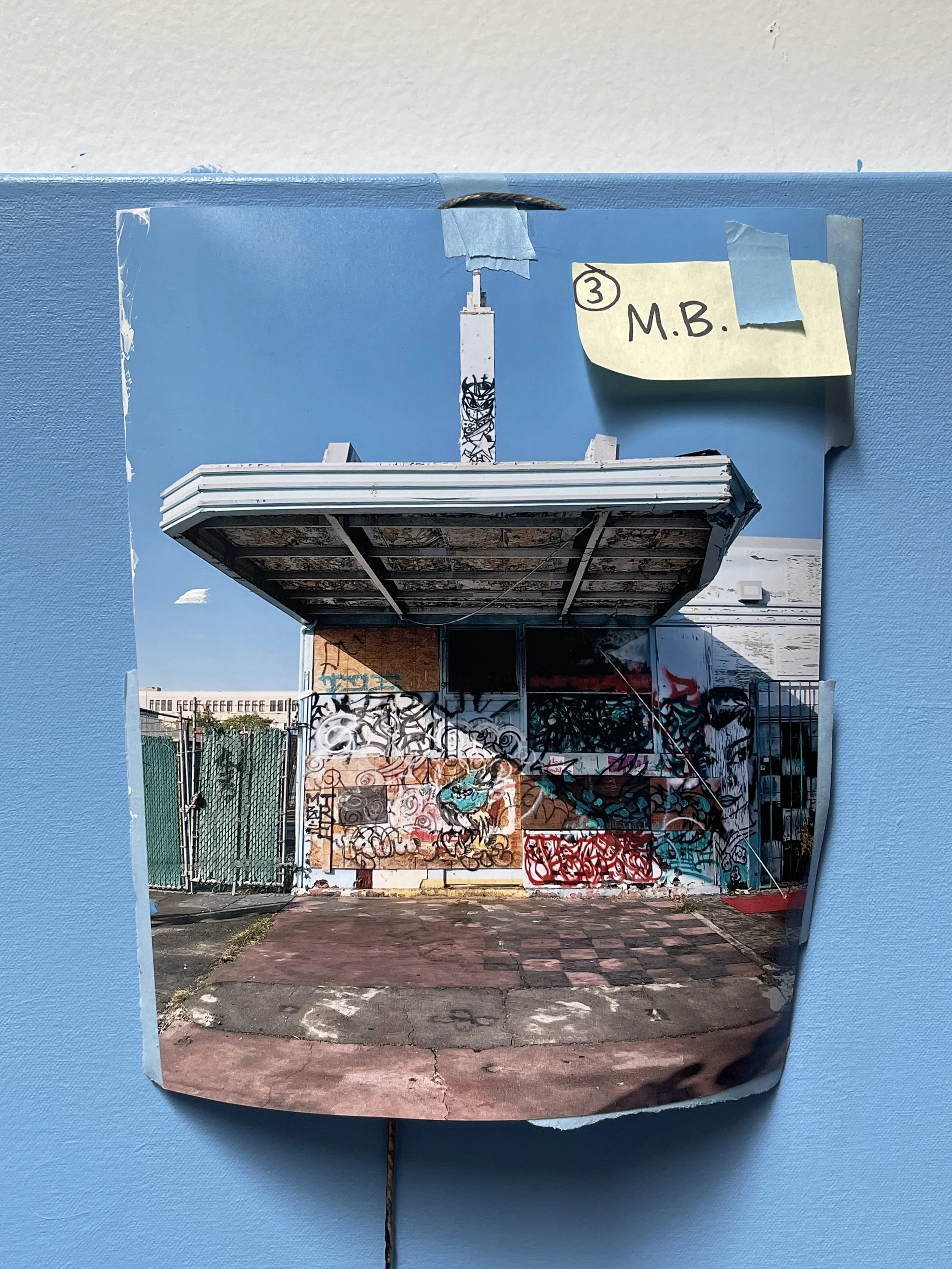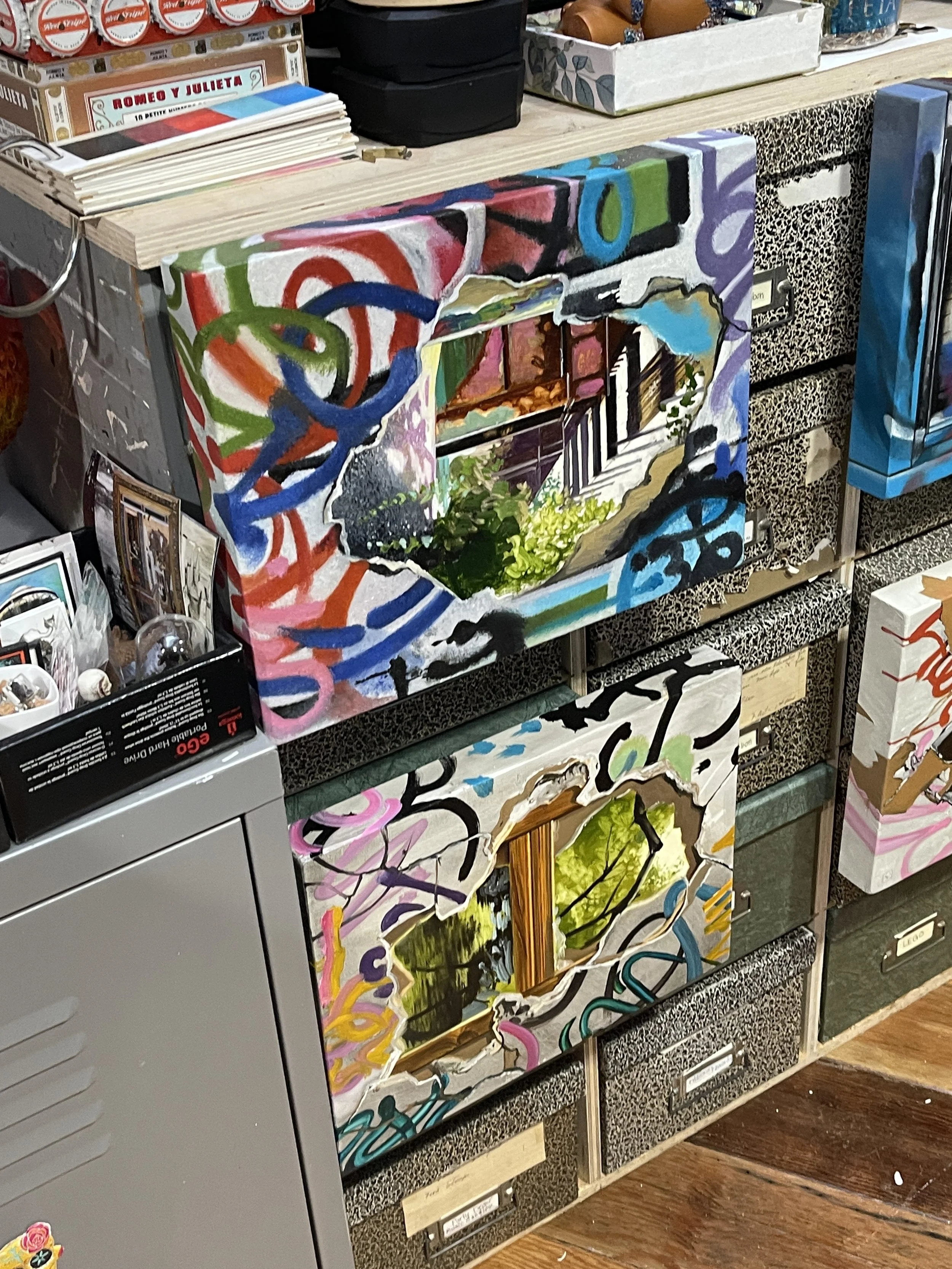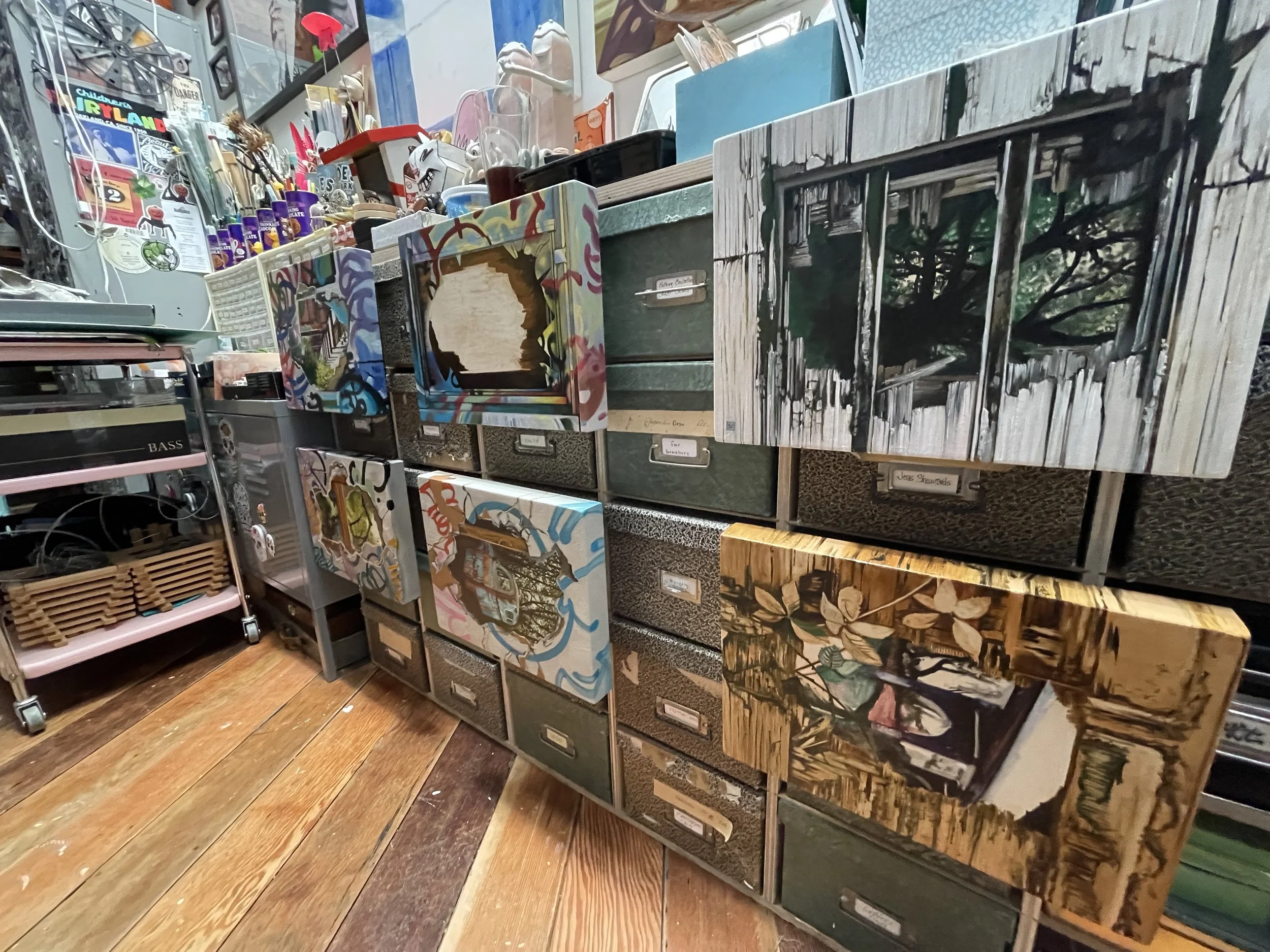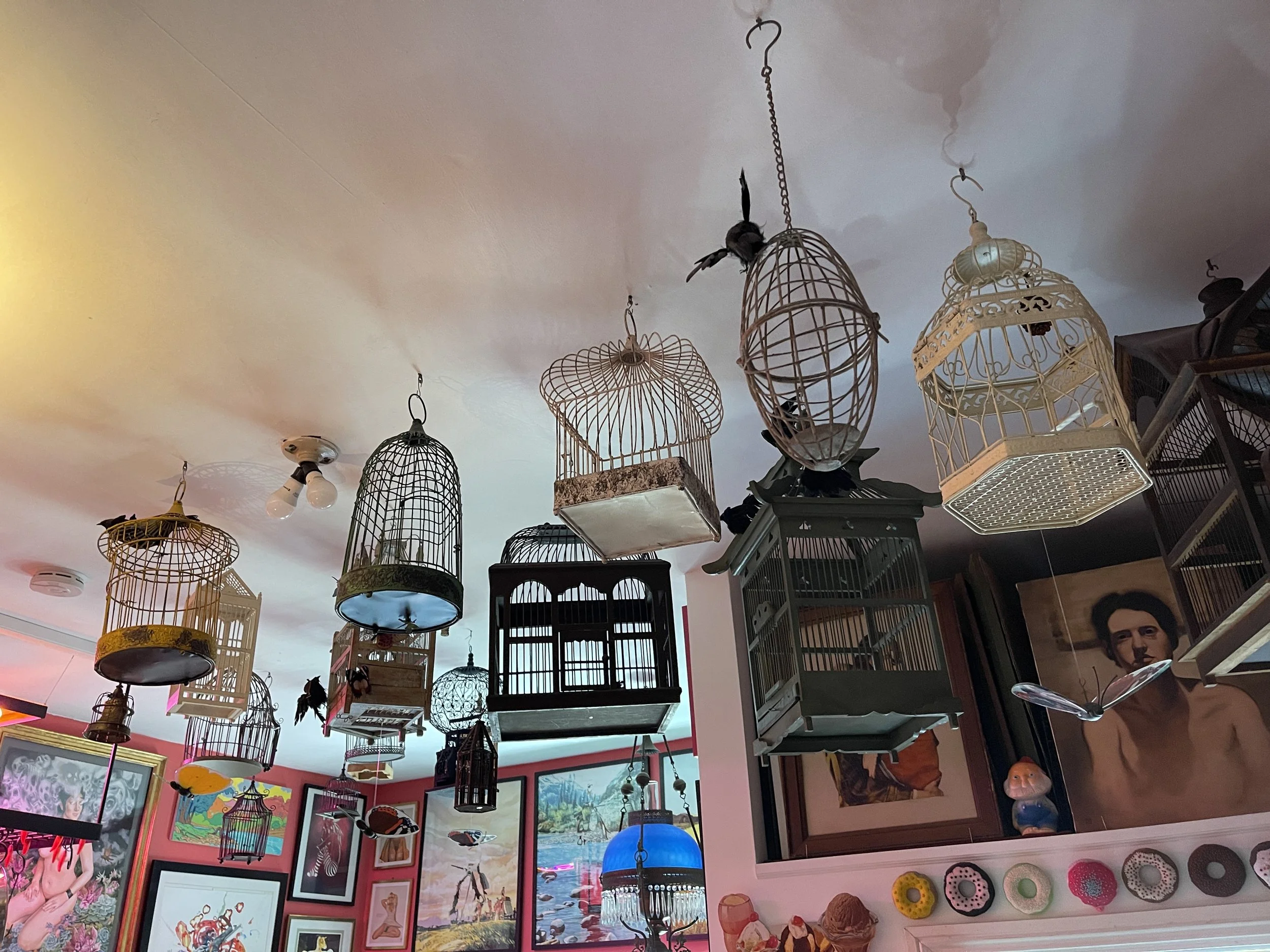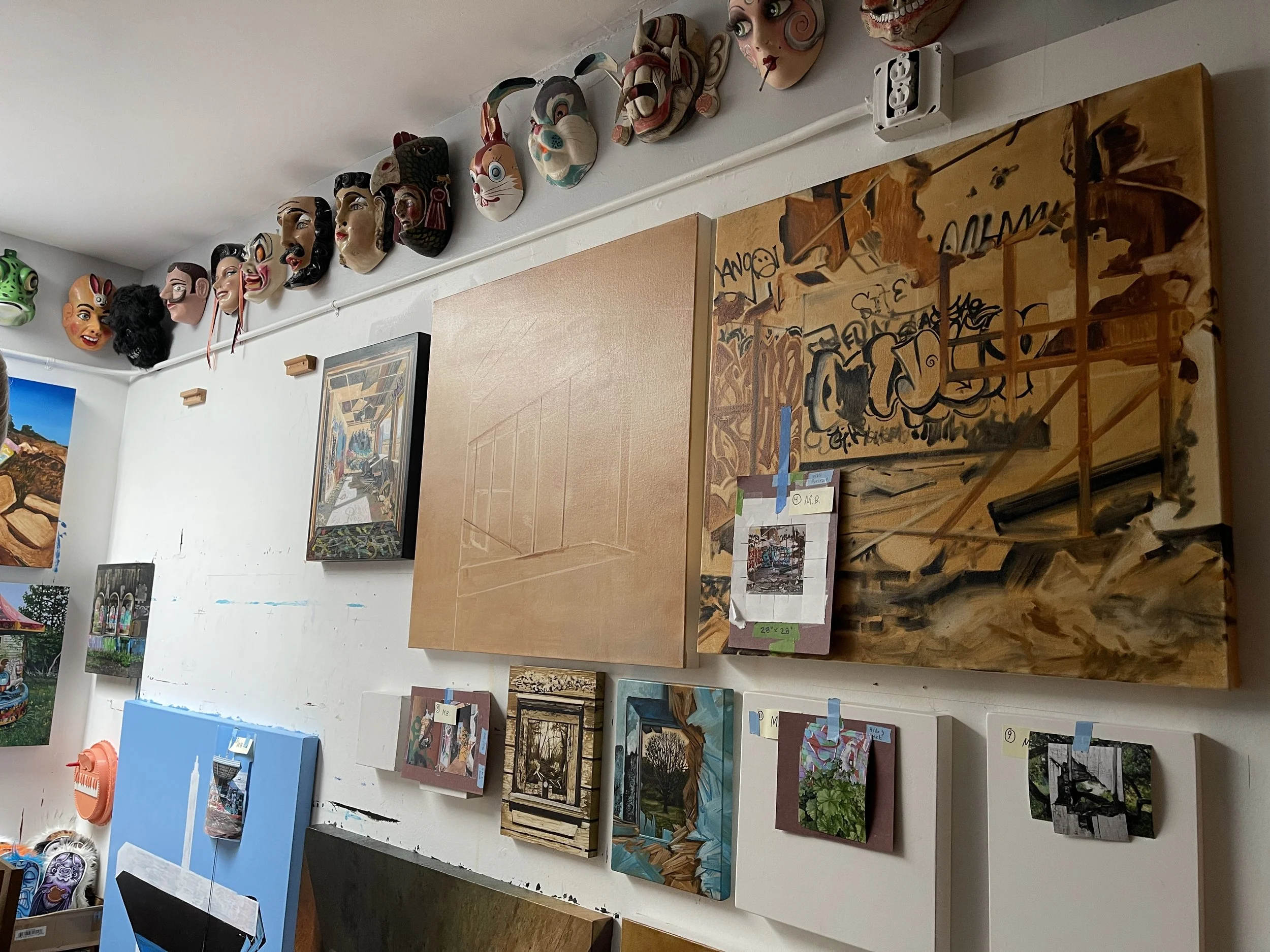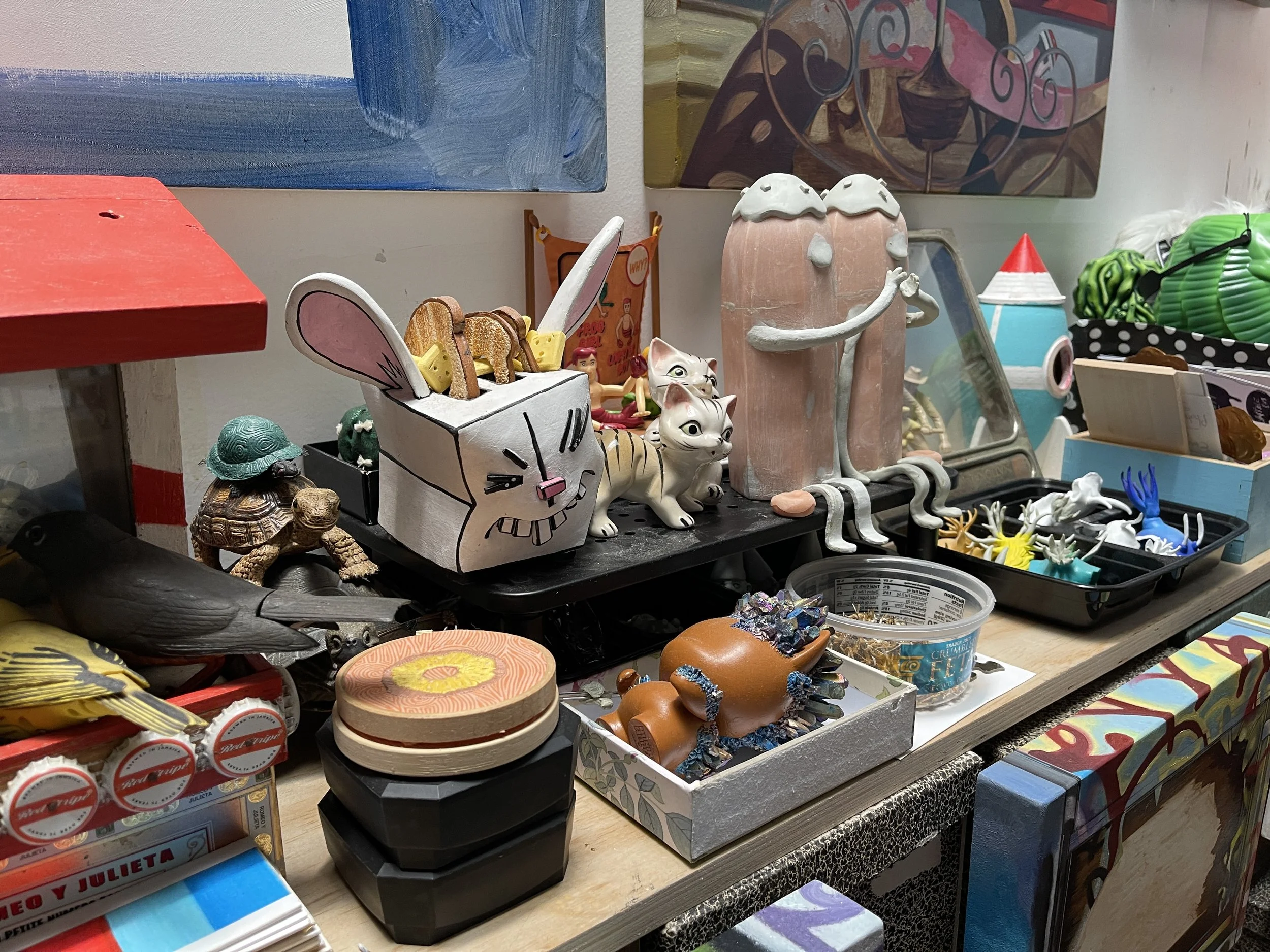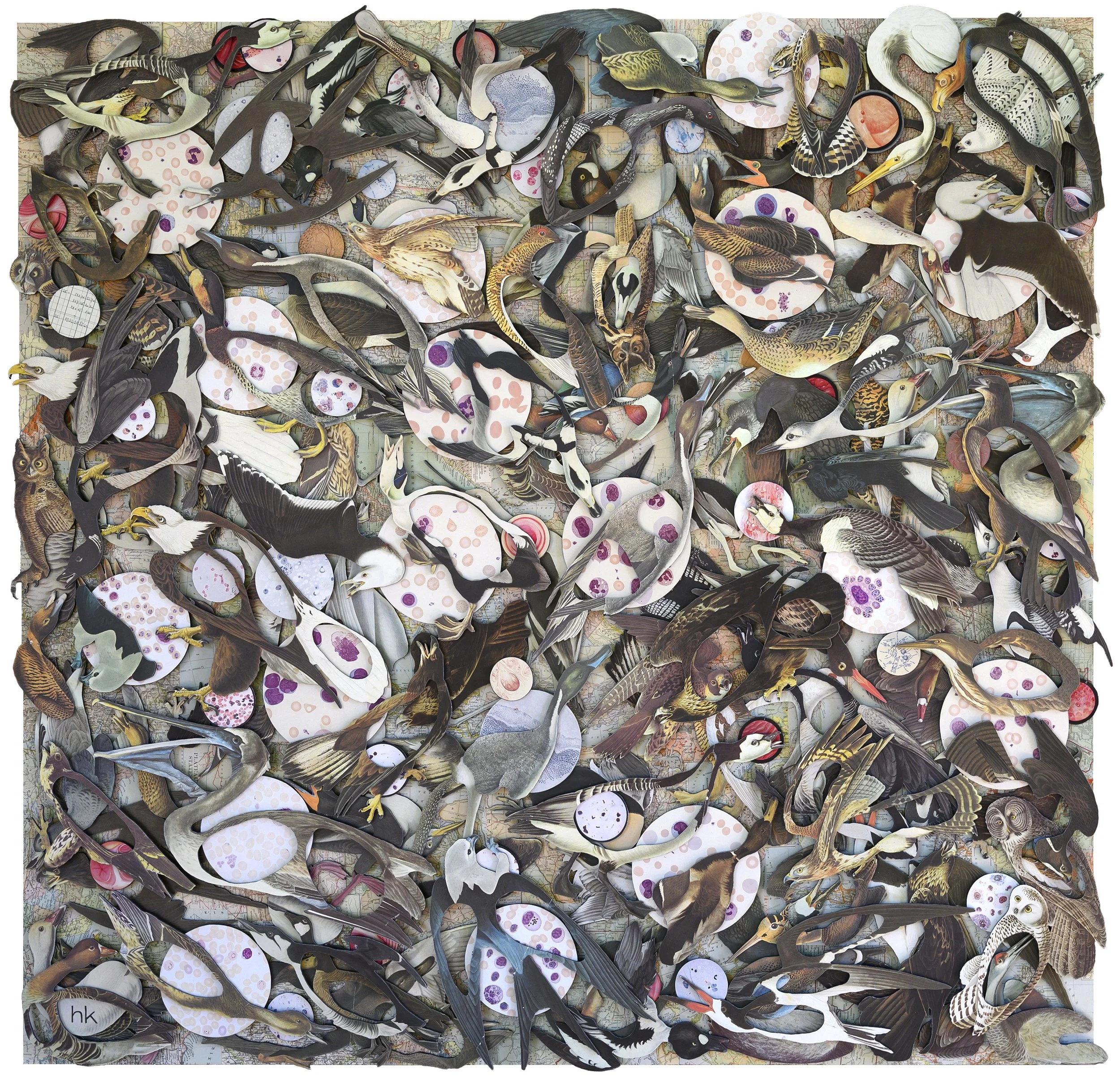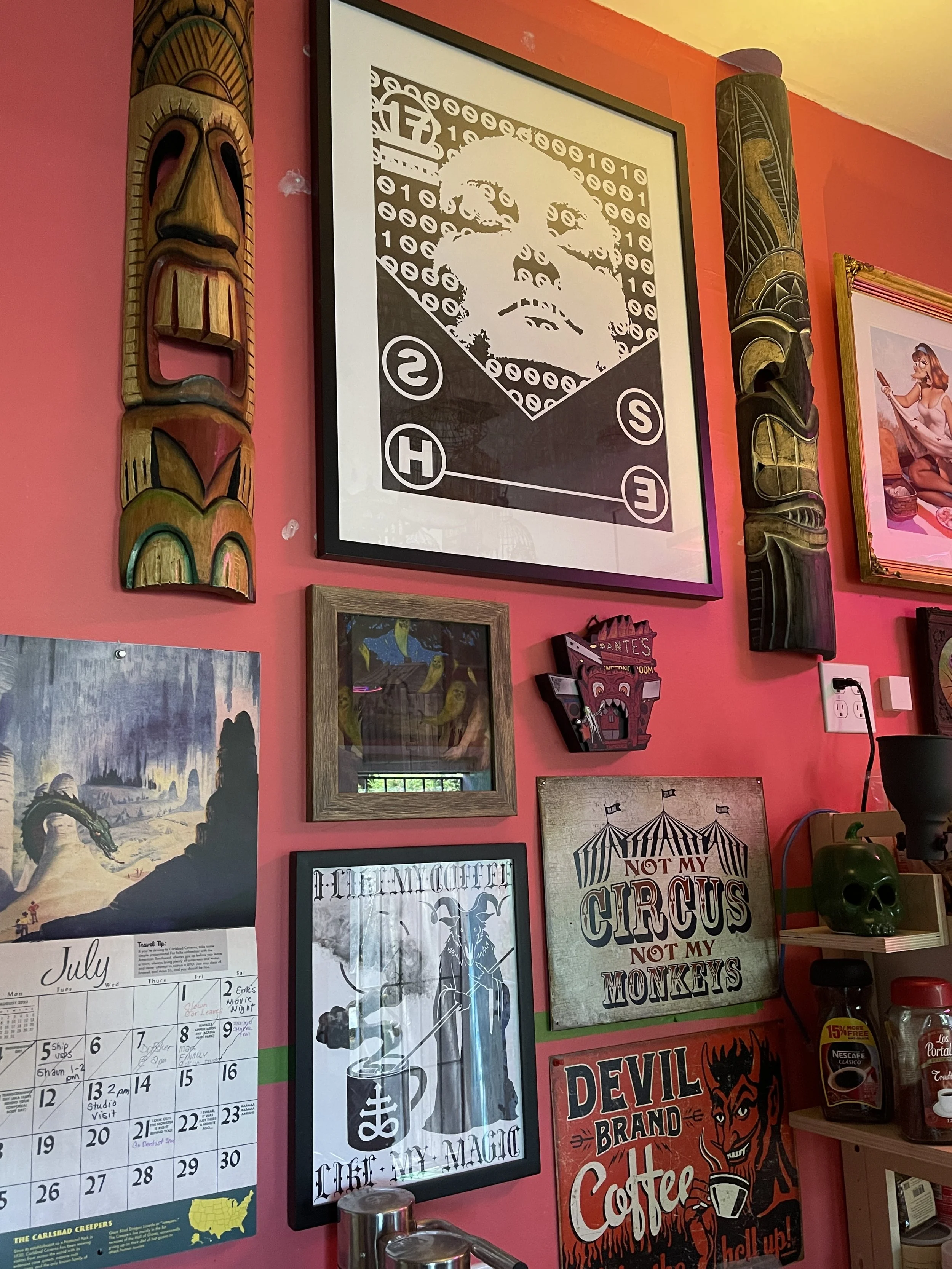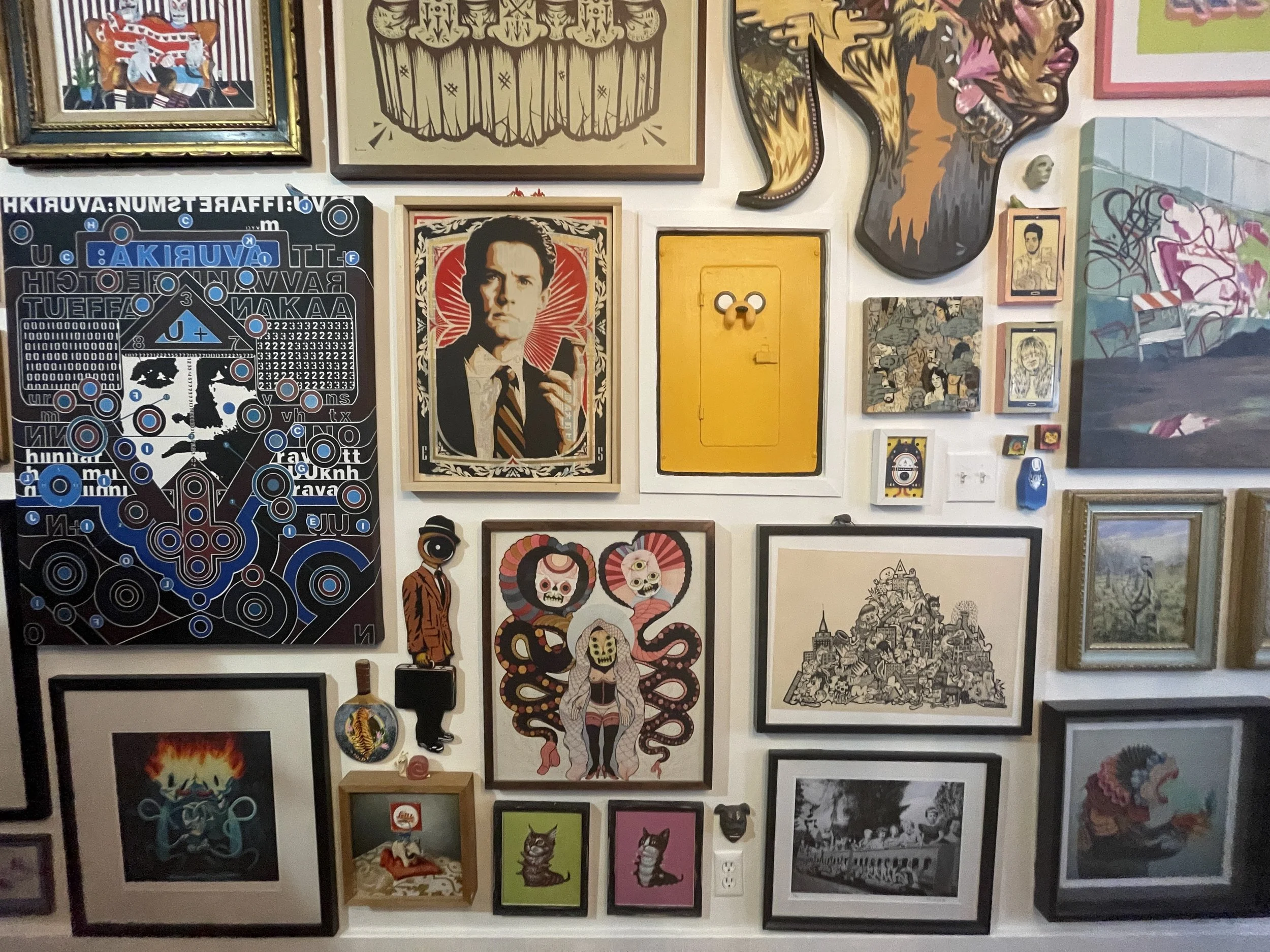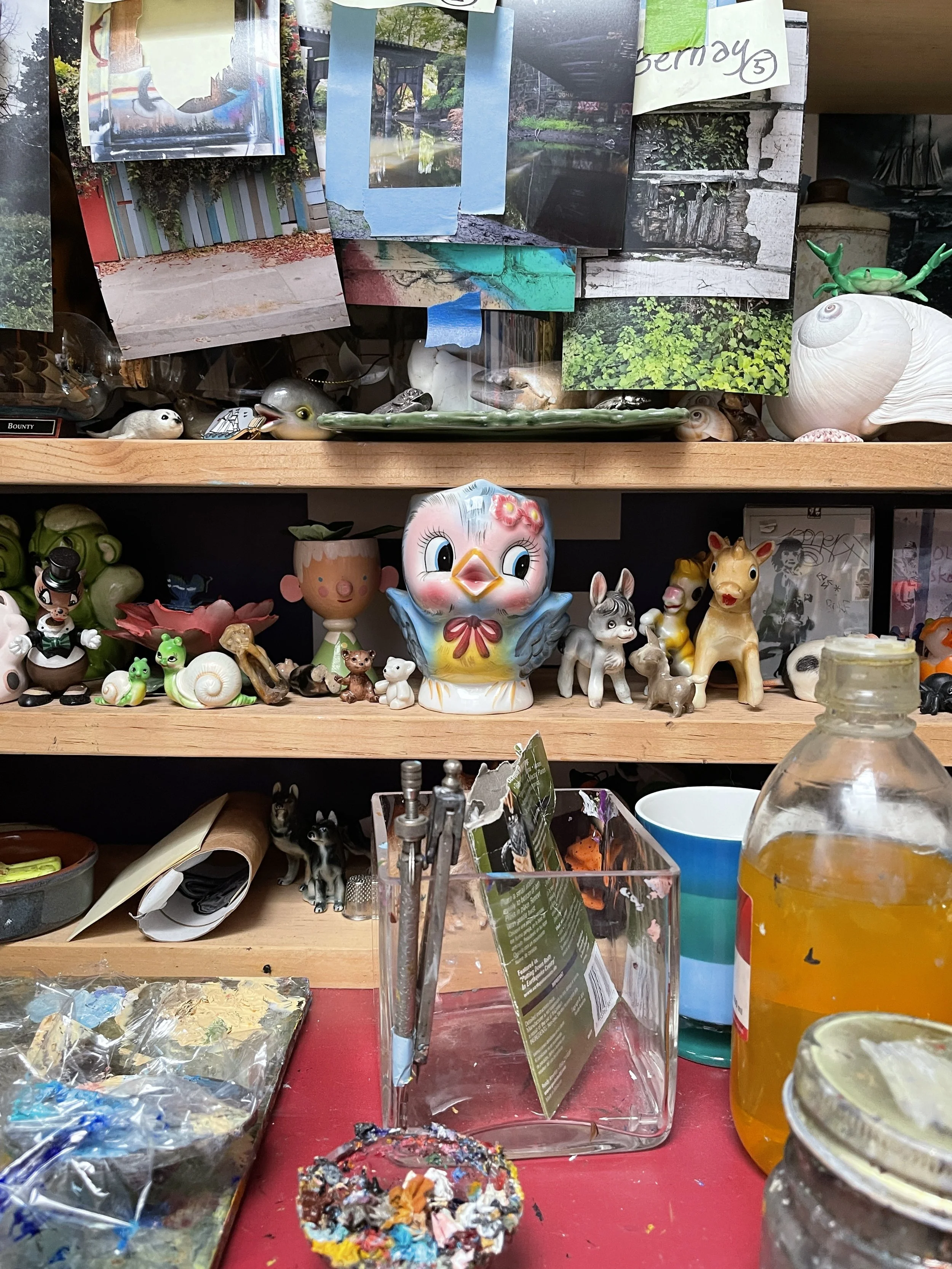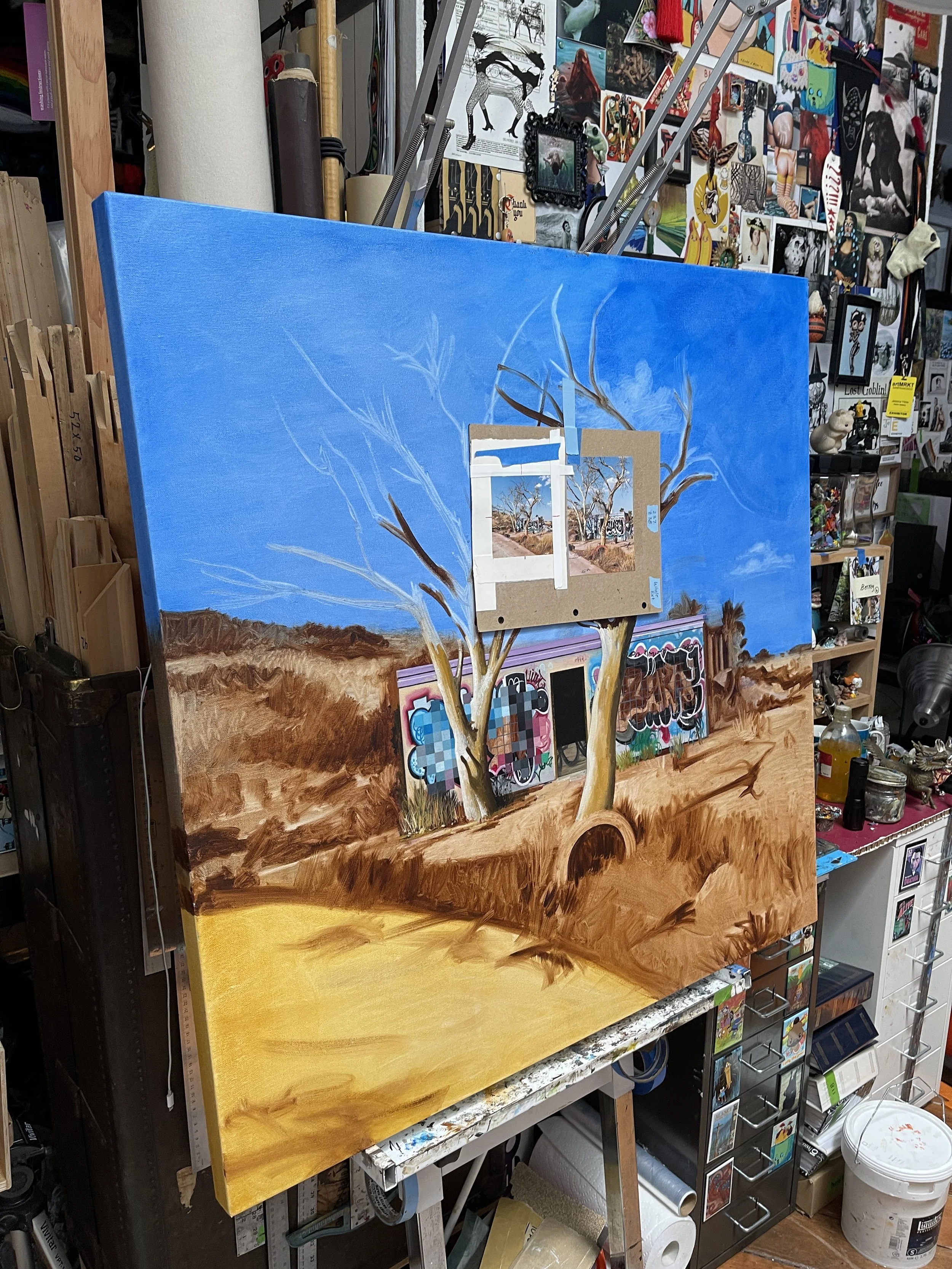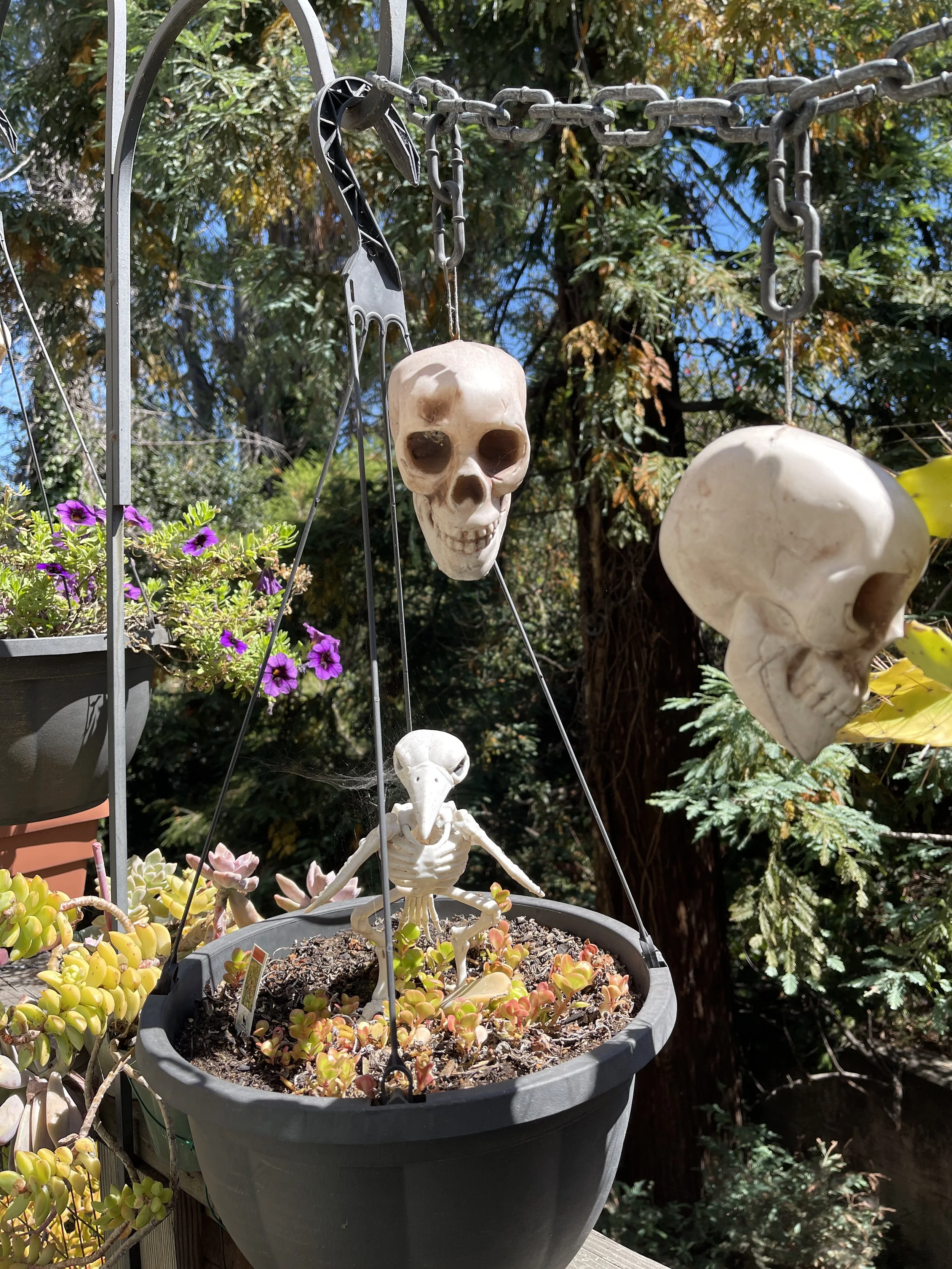Studio Visit & Interview with Jessica Hess
By John Vochatzer
Jess Hess is someone I am ceaselessly impressed with. Aside from being a phenomenal and innovative oil painter, she’s earned a longstanding reputation as an important member of the Bay Area artist community and huge supporter of fellow artists. On top of collecting more art than any other artist I’ve ever met, she has a long history of standing up for herself and others—often in situations where nobody else would. In tandem with our upcoming exhibit “Constant Variables” featuring Jess and veteran collage artist Hope Kroll who I have also been a longtime fan of, I made a trip to visit Jess’s home which she and her partner Mars have been steadily building into a beautiful, colorful oasis from near scratch in an old industrial building in Oakland. Seeing this place and all of the love and inventiveness being poured into it, as well as the countless other crafts, hobbies, and projects Jess keeps on the side, has multiplied my already enormous appreciation for her and everything she does.
The “wee” version of Jess’s studio.
Featuring an extensive collection of Halloween paraphernalia, a bathroom decorated with vintage nudie photos, and even a small Victorian house within-their-house; Jess and Mars’ abode is the stuff that artsy, Meow Wolf style tourist attractions are made of. I doubt selling tickets and letting hordes of strangers into their home is on their agenda any time soon, but if they do I will be one of the first people in line. Centered in the middle of their home is Jess’s studio and workspace which hosts her sweeping masterpieces along with any number of other craft projects she’s expertly working on at the same time. My favorite of these is probably the “wee” houses—elaborate dollhouses that look to have almost as much attention put into them as their main house, only in painstaking miniature. Jess also has the interesting custom of fabricating teeny tiny works of art for the wee houses in instances where she can’t find or afford an original from an artist. After seeing their home I can safely say that never before has being a “stuff” person seemed so downright appealing.
As for Jess’s main art practice, it’s on a level entirely it’s own. Pioneering a style of hyperrealist oil painting that focuses on the dilapidated ruins of urban society, often sheathed in layers of graffiti and vandalism—Jess’s latest series brings these vivid depictions of abandon and decay into our ever-evolving modern age by incorporating hand-painted pixellation techniques. This new work draws interesting lines between her classically trained approach and very corporeal subject matter—and the digital revolution we are all being inadvertently drawn into. It is left to the viewer to then ponder all of the existential questions posed therein. Personally, I find there to be a sublime beauty that Jess has discovered in this juncture between the debris of an old world and the advent of one that is new and still not yet fully understood. There are also hints of longing in this contrast—and perhaps consternation—as is common when on the verge of a total transformation as a society and as a species. And however one might feel about what the nuances of this new work may suggest, one thing is certain—it’s important that it exists, as it always falls into the lap of great artists to document the human experience in the most pivotal moments of history.
“American Canyon I” by Jess, part of the exhibit “Constant Variables” opening August 4th, 2022.
Interview
Hey Jess! Wow, your home and studio are amazing. You and Mars are putting a lot of love and hard work into the place and it shows—so much neat stuff to look at and explore. Can you tell me about this place in your own words?
If I were a bird, I’d be a bowerbird. If I were a crab, I’d be a decorator crab. Basically, I’m a collector and this is reflected in my home.
Jess in front of the mini Victorian house within their house.
My better half and I are enjoying building a fun and creative live/work space that showcases our various collections. I remember when my partner, Mars, and I discussed moving in together and I flippantly said something like… ”Well, if you want to live in a treehouse and slide down a fireman’s pole into an astro-turf covered, faux jungle, Tiki themed kitchen every day then you’re on!” and to my delight, this was also his vision of our future. Alrighty then, let’s demo some walls! And we did. Five years ago we were lucky to finally buy a commercial building in Oakland, CA. It was basically rotting away but we knew we could save it. TLC. Tender. Loving. Cash. Although it’s more like blood, sweat, and tears because we do almost all the cleaning, demolition, and renovation ourselves. It was really difficult to get the kind of space we wanted as we are not “house” people. We are “warehouse” people. However, so were all the weed growers who were buying up warehouse spaces in town at the time and their pockets were much deeper than ours. It took some searching but we eventually found a small commercial building that used to have an old barber shop on the first floor. Too small for them, juuuuust big enough for us. After five years of work, finally, I think this year it's respectable enough to have guests over as a few of our major creative developments have come to fruition.
My dream space would be the Winchester Mystery House. Inspired by places like this we have built fun features into our home like secret passages and pirate trap doors in the floor. By far the most noticeable is a mini Victorian house that is our bedroom. Yes. It's a house inside our building and it's one of the perks of a mixed-use commercial property. It is still a work in progress but you can see where we are headed. We are not shy about bold colors or creative modifications. Hell, I painted the ceiling sky blue and will be adding clouds…. after my show at Moth Belly of course. We don't care about things like “resale value”. Nope, we like it weird. Sky’s the limit. If it sounds crazy, it probably is, and we are into it.
One of the many Halloween shrines in Jess & Mars’ home.
My better half and I are both stuff people. When we joined forces our collections grew and grew. Actually I think our collections screwed like rabbits in storage when we weren’t looking because stuff has gotten out of control. We love the Alameda antiques market and I should have stock in Etsy with all the shopping I do there. Mars describes our place saying “It's like you turned our heads inside out and smeared our brains on the wall.” um, gross, but I agree. Not a dull inch in sight, just right. For example, we both had respectable collections of masks when we met. Mars had mostly wooden, hand carved, antique pieces from around the world. Mine are a bit more contemporary including colorful plastic 1980’s Halloween and rubber wrestling masks. At least a hundred are hung and more wait patiently in storage until we build more walls.
Don’t get me wrong, we are not materialistic. I couldn’t care less about name brands and flashy cars. I think diamonds are as boring as dirt. These are all major turn-offs for me.. We are makers who have been having fun making something out of nothing for years. Dumpster diving and yard sales for life baby! We are just really good at fixing and refinishing things. It's deeply satisfying to do things ourselves. There is a lot of creative reuse in our place. If and when we do spend real, actual money, it is to collect art. More about that later…
On top of the oil painting for which you’re known for, you have several different craft hobbies ranging from “wee” houses, to carnival punks. Can you tell us a little bit about what you currently have going on in that arena? And how does it balance out with your art practice?
I think I have split art personalities. It's too bad there are only 24 hours in a day and I only have two hands. I could have pursued any number of other creative careers. I would have made a good toy designer. I think about professional costume design often as well. Sometimes I fantasize about designing mini golf courses for a living, this one is truly a fantasy because seriously, what is the demand for new mini golf courses? Not much I’m guessing. Anyway, I have a lot of creative interests ranging from sewing, sculpting, felting, photography, drawing, framing, jewelry making, gardening, miniatures, etc., etc., till the cows come home….Sadly everything except urban landscape painting has been relegated to being just a hobby.
I like sculpting and painting my own original toys. I get back to my Illustration Major roots when I make Adventure Time and Bob’s Burgers fan art. Just for fun, just for me. I have fun making pop-up cards for my father. Every October I make some pretty elaborate Halloween costumes for myself and select friends. I am sure to never schedule art shows for the month of October as these are my personal “High Holy Days” during which I carve a dozen pumpkins, make costumes, and do some major home decorating. But honestly, my Halloween decor is up all year.
I kinda hoard craft supplies. Need black hot glue? Any color of felt? Need to gold leaf something at midnight? Weirdly enough I got it and so much more. For example, during shelter-in-place I designed and stitched up a dozen carnival punks just for fun. I looked around and thought yea, I don’t even need to go shopping. I had a dozen kinds of fake fur, heavy canvas, pillow stuffing, buckets of colorful thread, and acrylic paint all in studio. There were not many art shows during the first two years of Covid so yea, I made carnival punks..
Jess’ work-in-progress carnival punks (right).
My new favorite and most time consuming craft-tastic hobby is creating miniatures. To be specific, I am working on two separate dollhouses. But I don’t play with dolls so I call them my “wee houses”. I got into this about ten years ago when my best friend Suzanne purchased an unfinished dollhouse for her daughters. However, they turned out to be too young for such a delicate toy as evidenced by their attempts to physically climb inside the house followed by a Godzilla-like attack on the exterior on the very first day. So, Suz gave it to me not wanting it to be completely destroyed and knowing I could probably work tiny wonders. Well that gift opened up a whole can of worms I didn’t know I’d be into but turns out I’m obsessed. I’ve been refinishing it slowly, complete with a goth bedroom, Tiki bar, a Halloween themed dining room, and even a tiny version of my own studio in the attic. I made a little IKEA cart out of scrap aluminum and wire just like the one I use, complete with tiny pencils I carved from toothpicks and little clay tubes of paint. Too much fun.
Luckily all of these things recharge my painting battery so-to-speak. If I get burned out sitting at my easel it is incredibly helpful to shift creative gears for a bit and do something different. I'll pick up the quilt I'm making from silk screened patches or sculpt a mask. In no time I am refreshed and can get back to painting. I am always making something.
It was interesting hearing about your long background as a painter, and how you had formal training in realism starting from a pretty young age. What were the early days as an artist like for you?
My very supportive parents arranged painting lessons for me as a child back in North Carolina. I spent every Saturday morning painting under the guidance of our town's most notable portrait painter. He accepted few students, gave one-on-one classes, and only did so after an initial interview. I believe I was his youngest student. I remember his whole house smelling like turpentine and the walls were hung with his art top to bottom, salon style. I would be given unsweetened tea every lesson and we would listen to NPR. These things, sans sugar and actual music, were non-negotiable and I would learn to enjoy them. At first, I would bring in photographs to reference as subjects and I painted things like portraits of my family, landscapes with our house, and my pet cat. Just for laughs I’ll include one here, Jess Hess, age ten.
Portrait of Jess’s cat, painted at age 10.
I started to paint commissioned works before high school. I’m not even sure how that got started but I remember doing portraits for friends of the family, my parents' co-workers, and for my teachers at school. I painted d0g portraits, beach houses, even my biology teacher’s beloved boat. All good practice. I wasn’t making much money, but good enough cash for a kid though. I guess technically that was my first job. I remember clients being pleasantly surprised by my works. One time a co-worker of my mother’s had requested a painting of her house. When finished and presented to her she exclaimed that it had been destined for the bathroom at her house but because it was so much better than she had expected she now planned on hanging it over her fireplace mantel in the living room. Well, this explains my lifelong distaste for bathroom art. Way to give an artist a complex.
One of the predominant themes in your art is a fixation on abandonment and decay. Where did your fascination with this come from, and when did you first start exploring these themes in your work?
I suppose it has to do with urban exploration. I was sneaking around empty warehouses as a teenager and full-on trespassing inside by college. I loved getting into the old mill buildings around Providence and Pawtucket Rhode Island. Friends and I were doing this well before “urbex” was a pop culture term. Whatever, I'm old. I was working with this imagery as a youth. Before I made paintings of industrial and abandoned architecture in college, I was taking pictures of them for class back in highschool. I was lucky to have a photography class at my high school with a full chemical dark room and everything. I was shooting film, yes, glorious film, and did so well through college. Digital artists today will never know the privacy and comfort of eating lunch in the darkroom and getting to avoid positively everybody.
Reference photo for a painting in progress.
Back to exploring places, there is of course a sense of danger and excitement from being somewhere you are not supposed to be, a sense of wonder from poking around places most people don't experience, and these feelings are addictive. I consider it a relatively “safe” high sans getting arrested, contracting tetanus, encountering junkies, falling through rotten flooring, and everyone's favorite boogeyman, asbestos.
While I liked rooting around these places, these wonderland-like facilities. I loved painting them. Taking these images home with me into studio was a way to make that feeling last. In a way I’d get to relive the experience through making paintings of these places while simultaneously collecting the un-collectable. When I do a painting of a place I internalize it and in a way it becomes mine.
And finally my works preserve and document these otherwise transitory spaces. Most of my subjects are destined to be renovated or torn down. By painting them I can keep them just how I like them. Decay can be really beautiful. The physical breakdown of architecture either as a result of abandonment, natural disaster, or just old age and decomposition, it is nature's abstraction. Mother nature makes great abstract art if you think about it. I enjoy the irony of thoughtfully planned and measured design, the geometry and rigidity of man’s buildings falling into the lovely chaos that is decay.
Coming up in just a couple weeks is your exhibit “Constant Variables” with us here at Moth Belly. This is your first exhibit since 2019. Can you tell us a little bit about this new body of work you’ve been working on? And how is it an evolution from your previous work?
My last solo show was in 2019 and it was called “The Chaos Aesthetic”. The new work still focuses on the same dilapidated, abandoned, subject matter but is now new and improved with pixelated graffiti!
I’ve explored some additional abandoned locations since my last show that I am excited to work with. Most notably the abandoned cement factory in American Canyon and the derelict Lake Dolores Waterpark. There are paintings of both in the new show.
Studio works in progress.
At Dolores I shot 900+ photos in 105 degree full sun. I explored the park for about an hour and definitely got sunburned. I was not prepared as these sorts of explorations happen quite spontaneously and almost always start with the words “Pull over!” I had seen photos of this place online for years but didn’t know where it was exactly until it was passing by our car window. My three traveling companions, bless their dehydrated little hearts, having returned to the air conditioned vehicle well before me, kindly requested I hurry things up before our tires melt into the pavement. But I was in my element, kid-in-a-candy-store, pig-in-shit, over-the-moon excited to finally explore that place. I only stopped because my phone overheated and its camera stopped working. If I can’t take photos of an amazing place then I don't want to be there. Not having my camera is like having my hands tied. On my way back to the car I was almost moved to tears at the sight of the empty lazy river, almost. Not only because the decay was so beautiful and because I love lazy rivers and seeing one empty was heartbreaking, but at that moment my body simply couldn’t spare the moisture. It was a very strange sensation.
One of the most recent developments in your work is the pixelation that you’ve been incorporating into your paintings since January of 2020. We talked about how this serves various functions, both on symbolic and more practical levels in your work. Where did the idea for this first come from? And what are some of these functions that it serves?
The pixelation was originally suggested by my good man Mars, who is a virtual reality game designer, as a way to set my work apart from other contemporary-realist-urban-landscape-painters. After bearing witness to me figuratively beating my head against a wall for years contemplating this problem of similarity, he put his thinking cap on. When your style is “realism” it’s easy to be confused with other “realist” painters especially when focusing on similar subject matter. It seems like there are many urban landscape painters these days that include real graffiti. It has become very popular…dare I say….trendy?
“Miami Pixels III",” another oil painting included in “Constant Variables.”
I only ever included graffiti as a way to get more color into my subjects. I’ll say it again. Graffiti artists are often excellent colorists. Over the years I became less interested in graffiti culture and didn’t want the appeal of my art to be based on the inclusion of other artists' contributions to the landscape. Some artists loved getting up in my paintings and others were not so jazzed to put it mildly. Either way it is no longer a concern of mine.
By pixelating the graffiti I set my works apart, I keep the color, eliminate unintended collaborations, and I give landscape painting a modern twist. And this twist is most interesting to me. The irony and juxtaposition of a modern digital element like pixels against my classically executed, Old Masters style of painting, is wonderfully odd. The rigid, evenly colored, geometric sections paired against the random organic forms in nature and decay is strangely satisfying. The pixels introduce an element of non-reality to my otherwise hyperreal images. I like the questions it raises about modern art, digital art, and augmented reality. Also, it hints at the idea that we are probably living in a simulation. Just kidding?
Joining you in the Constant Variables exhibit is your close friend, collage artist Hope Kroll. The two of you work in very different styles and I’m excited to see how they balance together in the show. Tell us a little bit about your friendship with Hope. And what are some of your thoughts on her work?
“Aviary” 48”x46” collage by Hope Kroll for Constant Variables.
I met Hope Kroll in NY back in 2015 when we both had work with Joseph Gross Gallery. We got to talking at a bar after the opening and found out we had a LOT in common. For starters we both live in California, within driving distance of each other actually. Neither of us has day jobs. We both have meticulous creative processes and tend to do things the hard way. Neither of us drive or have a license. Not huge fans of technology. We have similar taste in movies, especially horror. Perhaps most interesting to know is Hope is also very much into miniatures as well and has a killer dollhouse. So we compare notes, suggest mini shops, and gift each other little stuff back and forth. Over the years we have traded artwork and bought each other’s art many times. We occupy significant wallspace in each other’s homes. So yea, I’m a big Hope Kroll fan.
Out of all the artists I know in the Bay Area, you are perhaps the biggest artist-as-collector of them all—with one of the most amazing collections I’ve ever seen. Why do you think it is important for artists to also collect art? And what does the art that you keep in your home mean to you?
Awww. Thank you. Well it's really just me taking an interest. I make art, why not buy some art? I gravitate towards things I cannot make myself. I appreciate lots of other styles and materials and my taste in art is as eclectic as in music, just….all over the map. I want to surround myself with things that inspire me. Collecting reminds me of my peers, my community, of all the other creative weirdos out there trying to make a go of this “art” thing. And with that said. Artists need your support and patronage. An ongoing and successful career in the arts, specifically in the fine arts, is a very tough road indeed. Show a little love, buy a little art.
I have also traded art with fellow artists. When two artists have more talent than cash they trade! And I do so often because art is just about the most interesting thing to have in your home. It's a great conversation starter.
Portrait of Jess by D Young V (top center) in Jess & Mars’ Tiki-themed kitchen.
Now off with you, go! Support artists! Buy more art, and I mean good art, not that factory crap at Bed Bath & Beyond! You are better than that if you’ve read this far! No blank walls!
Something we’ve talked about is your appreciation for a lot of the more self-taught or “naïve” art styles. This is an interesting contrast against your highly refined approach to painting. Can you talk a little bit about where this appreciation comes from? And are there any artists working in these styles that you’re a particular fan of?
I think the truly original thinking and fresh approach to art making found in Naive art, folk art, primitive art, and outsider art is wonderfully playful and child-like. Think, Henry Darger. They are often unconcerned with contemporary trends or rather uncontaminated by them. I enjoy works that have no real attempt to create the illusion of three dimensional reality, no consideration of perspective or creating illusions by shading. Works are often flat, sometimes cartoonish, always fun. If you want an old school example then I’ll proclaim my love here for the works of Henri Rousseau. A more contemporary example would be Max Seckel. Max, if you are reading this, big fan, wanna trade? Haha. Fred Stonehouse is another contemporary favorite.
A very small portion of Jess & Mars’ enormous art collection.
Also, on the subject of folk/outsider artists, you should know about John Preble, he created The Abita Mystery House/UCM Museum. It has been described as Louisiana's “most eccentric attraction”. Do yourself a favor if you are ever in Abita Springs, Louisiana spend an afternoon exploring the sprawling magic and wonder that starts at at vintage service station, continues through multiple buildings adorned with broken crockery, down the hall with a dozen homemade interactive dioramas, through a dome made of old wine bottles, left out the Mardi Gras Room, past the UFO in the yard to the 32 “foot” taxidermy alligator….and beyond. Inside the museum you will see many wonderful art installations and interesting collections. There are a lot of paint-by-number works, a paper mache devil, and a Fiji Mermaid to drop a few favorites here. There are funny hand painted signs everywhere, it's funky, it's colorful, and it's mostly covered with bottle caps. I love it. John Preble is a collector, a sculptor, an all around creative force with a good sense of humor and if you have the time please check it out.
Overall I think I admire these qualities because they have been thoroughly schooled-right-out of me. My art is incredibly refined and uptight by comparison. Naive art is something I can never make, I've tried, I'm terrible at it. One cannot undo years of study and practice. I admire these artists' work greatly because I simply can’t create anything like it myself, not even if I went back in time I don't think. At my core I'm just a very different kind of artist.
Last question: What’s next for you after Constant Variables? Do you have anything coming up or any new directions that you’d like to be taking you and your work?
I have no trouble at all keeping myself busy with our building renovations, crafting my wee houses, gardening, and a dozen other projects. I’ve got photo reference to last me a decade and lots of ideas in the vault.
But since 2019 I've had a hard time getting back into the studio. I have not been very productive in the fine art department. I have a love/hate relationship with the art world and haven't had the best of luck working with galleries. Honestly, a few bad experiences really got me down.
I had taken a big break from painting until you offered me a show at Moth Belly so I thank you for helping me want to make art again.
I've been happier in studio. Hopefully that sticks. For the near future I’ll just keep making art for art’s sake.
